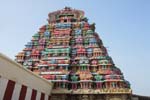The Swayam Vyakta Vishnu Kshetrams of Tamil Nadu
As scholars have to argue, and pilgrims know instinctively, the land of India is constituted of circuits of shrines and places. Points on these circuits sometimes coincide, and at other times, the circuits coincide even when these points are distinct. One of these circuits is that of the eight ‘svayam-vyakta Viṣṇu kṣetrams’- the eight special regions where the Lord manifested Himself independently. These are Srimushnam, Srirangam, and Totadri in Tamil Nadu; Tirupati in Andhra Pradesh; Naimisharanya in Uttar Pradesh; Pushkar in Rajasthan; Badrinath in Uttarakhand; and Muktinath in Nepal.
Even a cursory look demonstrates the intersections in these sacred circuits; Badrinath, for instance, is also one of the four dhams. Several of them are also included within the 108 divya desams revered in the Vaisnavite traditions in southern India. The forms of the deity in these eight places also correspond with the Ashtakshara (eight-lettered) mantra of Vishnu. Visiting each of them can help intensify the penetration of the syllable in one’s consciousness.
The Swayam Vyakta Vishnu Kshetrams of Tamil Nadu
The Lord in Srimushnam is called Bhu-Varahaswamy, the form in which he rescued Bhudevi (Mother Earth) from the demon Hiraṇyākṣa. The temple itself is in a quiet little town, about four hours’ drive from Kanchipuram. The town is also home to an old Shiva temple nearby. A temple to Sri Ram is right next to the entrance, as well as a temple to the Lord Venkatesvara. Sri Ram, here, is sitting peacefully rather than standing. At Srimushnam, the main idol of the deity is standing rather flamboyantly, with the face turned sideways even as the body faces the devotees. It is said that He faces the demon upon his request. It is sometimes said that He has three manifestations in Srimushnam: the main idol, the temple tank, and a tree near the tank. Usually, it is said that the Sri Varaha Kavacham and the Gayatri mantra should be recited or mentally repeated here. The Varaha Kavacham (https://ramanujadasan.wordpress.com/2013/05/30/sri-varaha-kavacham-recitation-meaning/) is focussed specifically on the deity at Srimushnam, and it describes the greatness of Srimushnam, pointing out that the Ganga, emerging from the Lord’s toe is considered all-purifying; imagine how much more so this tank must be, emerging from His entire body!
Another two or three hours from Srimushnam is perhaps the best known of the svayam-vyakta Vishnu ksetrams, and the one which heads most lists - Sriranganathaswami. It is described in one of the earliest collections of ‘bhakti’ poetry, having been praised in compositions included in the Divya-prabandham. All of the Azhwars sang of it, making it a divya desam par excellence. Ramanujacharya, the great Srivaishnava scholar-saint, lived here. At the same time, it has also been praised by successors to the Shankaracharya title. The main form of the deity here is Vishnu in a reclining posture. The temple complex itself houses several shrines. The story goes that when Vibhishana was returning to Lanka, Sri Ram gave him the Sriranga temple (which had been in Sri Ram’s family for some time) as a present. On his way back, Vibhishana put it down as he rested, and then it refused to move! Even so, He promised Vibhishana that He would face southward so that Vibhishana could constantly receive his blessing.
Driving from Srimushnam to Kanyakumari at about five hours’ distance, one would pass through a little town called Nanguneri. Here, one would find the Totadri Math, and Vannamamalai Perumal, to whom the shrine here is dedicated. This, too, is both a svayam vyakta Vishnu kshetram as well as a divya desam. The deity here is seated with his consort, Sri, and Bhudevi. The ruler who is said to have built the temple found that the Lord’s manifestation here was wounded and bleeding, and because of that, He is treated with medicinal oils which are then available as prasada. This place is also important because the Totadri Math is an important seat for the Srivaishnavas.
The Alwars, from at least a millennium and a half ago, consecrated this part of India’s sacred land with their songs, and with their repeated realizations of Vishnu. Over the centuries, through the spirituo-philosophical lineages of Ramanujacharya et al, we find a constant renewal and re-articulation of that impulse; this impulse also informs the saints more familiar in north India. The way the svayam-vyakta Vishnu kshetrams are distributed across the subcontinent is, in a sense, an affirmation of this. Making the pilgrimage to each of these places, the pilgrim sees the Lord and His devotees, immerses herself ever more surely into the Ashtakshara mantra, and finds an ever more stunning manifestation of the Lord.














